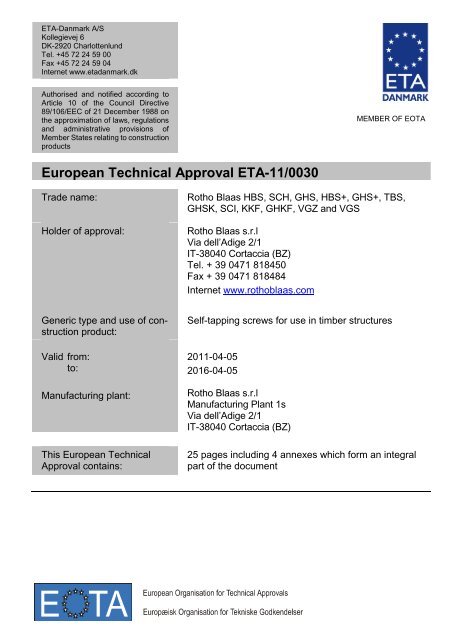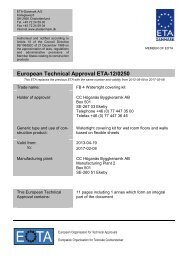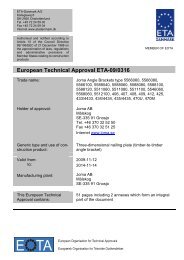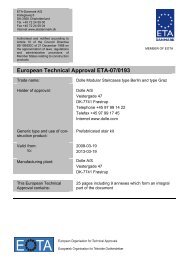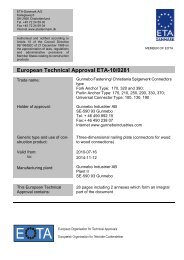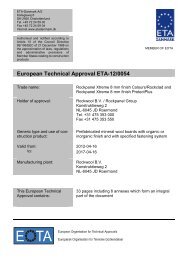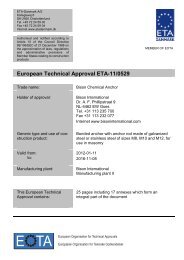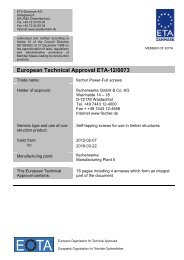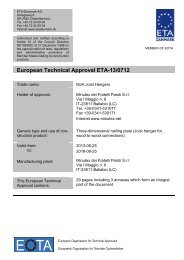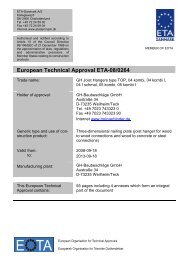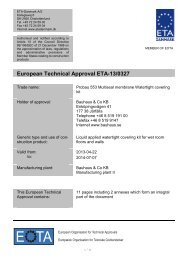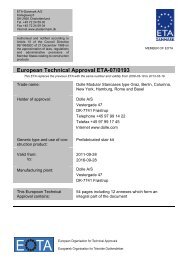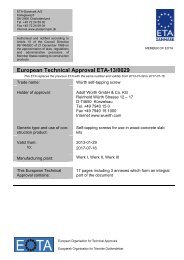ETA110030 RB screws - ETA-Danmark
ETA110030 RB screws - ETA-Danmark
ETA110030 RB screws - ETA-Danmark
You also want an ePaper? Increase the reach of your titles
YUMPU automatically turns print PDFs into web optimized ePapers that Google loves.
<strong>ETA</strong>-<strong>Danmark</strong> A/S<br />
Kollegievej 6<br />
DK-2920 Charlottenlund<br />
Tel. +45 72 24 59 00<br />
Fax +45 72 24 59 04<br />
Internet www.etadanmark.dk<br />
Authorised and notified according to<br />
Article 10 of the Council Directive<br />
89/106/EEC of 21 December 1988 on<br />
the approximation of laws, regulations<br />
and administrative provisions of<br />
Member States relating to construction<br />
products<br />
European Technical Approval <strong>ETA</strong>-11/0030<br />
Trade name:<br />
Holder of approval:<br />
Generic type and use of construction<br />
product:<br />
Valid from:<br />
to:<br />
Manufacturing plant:<br />
This European Technical<br />
Approval contains:<br />
MEMBER OF EOTA<br />
Rotho Blaas HBS, SCH, GHS, HBS+, GHS+, TBS,<br />
GHSK, SCI, KKF, GHKF, VGZ and VGS<br />
Rotho Blaas s.r.l<br />
Via dell’Adige 2/1<br />
IT-38040 Cortaccia (BZ)<br />
Tel. + 39 0471 818450<br />
Fax + 39 0471 818484<br />
Internet www.rothoblaas.com<br />
Self-tapping <strong>screws</strong> for use in timber structures<br />
2011-04-05<br />
2016-04-05<br />
Rotho Blaas s.r.l<br />
Manufacturing Plant 1s<br />
Via dell’Adige 2/1<br />
IT-38040 Cortaccia (BZ)<br />
25 pages including 4 annexes which form an integral<br />
part of the document
I LEGAL BASIS AND GENERAL<br />
CONDITIONS<br />
Page 2 of 25 of European Technical Approval no. <strong>ETA</strong>-11/0030<br />
1 This European Technical Approval is issued by<br />
<strong>ETA</strong>-<strong>Danmark</strong> A/S in accordance with:<br />
- Council Directive 89/106/EEC of 21 December<br />
1988 on the approximation of laws, regulations<br />
and administrative provisions of Member States<br />
relating to construction products 1) , as amended by<br />
Council Directive 93/68/EEC of 22 July 1993 2) .<br />
- Bekendtgørelse 559 af 27-06-1994 (afløser<br />
bekendtgørelse 480 af 25-06-1991) om ikrafttræden<br />
af EF direktiv af 21. december 1988 om<br />
indbyrdes tilnærmelse af medlemsstaternes love<br />
og administrative bestemmelser om byggevarer.<br />
- Common Procedural Rules for Requesting,<br />
Preparing and the Granting of European Technical<br />
Approvals set out in the Annex to Commission<br />
Decision 94/23/EC 3) .<br />
2 <strong>ETA</strong>-<strong>Danmark</strong> A/S is authorized to check whether<br />
the provisions of this European Technical<br />
Approval are met. Checking may take place in the<br />
manufacturing plant. Nevertheless, the responsibility<br />
for the conformity of the products to the<br />
European Technical Approval and for their fitness<br />
for the intended use remains with the holder of<br />
the European Technical Approval.<br />
3 This European Technical Approval is not to be<br />
transferred to manufacturers or agents of manufacturers<br />
other than those indicated on page 1, or<br />
manufacturing plants other than those indicated<br />
on page 1 of this European Technical Approval.<br />
4 This European Technical Approval may be<br />
withdrawn by <strong>ETA</strong>-<strong>Danmark</strong> A/S pursuant to<br />
Article 5(1) of Council Directive89/106/EEC.<br />
1) Official Journal of the European Communities N o L40, 11 Feb 1989, p 12.<br />
2) Official Journal of the European Communities N o L220, 30 Aug 1993, p 1.<br />
3) Official Journal of the European Communities N o L 17, 20 Jan 1994, p 34.<br />
5 Reproduction of this European Technical Approval<br />
including transmission by electronic means shall be<br />
in full. However, partial reproduction can be made<br />
with the written consent of <strong>ETA</strong>-<strong>Danmark</strong> A/S. In<br />
this case partial reproduction has to be designated as<br />
such. Texts and drawings of advertising brochures<br />
shall not contradict or misuse the European Technical<br />
Approval.<br />
6 This European Technical Approval is issued by <strong>ETA</strong>-<br />
<strong>Danmark</strong> A/S in English.<br />
This version corresponds fully to the version circulated<br />
within EOTA. Translations into other languages<br />
have to be designated as such.
Page 3 of 25 of European Technical Approval no. <strong>ETA</strong>-11/0030<br />
II SPECIAL CONDITIONS OF THE<br />
EUROPEAN TECHNICAL APPROVAL<br />
1 Definition of product and intended use<br />
Rotho Blaas “HBS”, “HBS+”, “TBS”, “KKF“, “SCI“,<br />
“VGS” and “VGZ” <strong>screws</strong> are self-tapping <strong>screws</strong> to be<br />
used in timber structures. “HBS” <strong>screws</strong> are also called<br />
“SCH” or “GHS” <strong>screws</strong>, “HBS+” <strong>screws</strong> are also called<br />
“GHS+” <strong>screws</strong>, “KKF” <strong>screws</strong> are also called „GHKF”<br />
<strong>screws</strong> and “TBS” <strong>screws</strong> are also called “GHSK” <strong>screws</strong>.<br />
Rotho Blaas “HBS”, “HBS+”, “TBS”, “KKF“ and “SCI”<br />
<strong>screws</strong> shall be threaded over a part of the length. Rotho<br />
Blaas “VGS” and “VGZ” <strong>screws</strong> shall be threaded over the<br />
full length. The <strong>screws</strong> shall be produced from carbon steel<br />
wire for nominal diameters of 3,0 mm to 12,0 mm and<br />
from stainless steel wire for nominal diameters of 3,5 mm<br />
to 8,0 mm. Where corrosion protection is required, the<br />
material or coating shall be declared in accordance with the<br />
relevant specification given in Annex A of EN 14592.<br />
Geometry and Material<br />
The nominal diameter (outer thread diameter), d, shall not be<br />
less than 3,0 mm and shall not be greater than 12,0 mm. The<br />
overall length, L, of <strong>screws</strong> shall not be less than 20 mm and<br />
shall not be greater than 600 mm. Other dimensions are<br />
given in Annex A.<br />
Screw types “HBS”, “SCH”, “GHS”, “HBS+”, “GHS+”,<br />
“TBS”, “GHSK”, “VGS” and “VGZ” are made from<br />
carbon steel<br />
Screw types “KKF“ and “GHKF” are made from<br />
martensitic stainless steel 1.4006 and SCI are made from<br />
stainless steel grade 1.4401 or 1.4567.<br />
The ratio of inner thread diameter to outer thread diameter<br />
di/d ranges from 0,55 to 0,69.<br />
The <strong>screws</strong> are threaded over a minimum length lg of 3,3·d<br />
(i.e. lg > 3,3·d).<br />
The lead p (distance between two adjacent thread flanks)<br />
ranges from 0,44·d to 0,76·d.<br />
No cracks shall be observed at a bend angle, α, of less than<br />
(45/d 0,7 + 10) degrees.<br />
Intended use<br />
The <strong>screws</strong> are used for connections in load bearing timber<br />
structures between members of solid timber (softwood),<br />
glued laminated timber, cross-laminated timber, and<br />
laminated veneer lumber, similar glued members, woodbased<br />
panels or steel. Rotho Blaas “VGS” and “VGZ”<br />
<strong>screws</strong> are also used as tensile or compressive reinforcement<br />
perpendicular to the grain.<br />
Furthermore Rotho Blaas <strong>screws</strong> with diameters between<br />
6 mm and 12 mm may also be used for the fixing of thermal<br />
insulation material on rafters.<br />
Steel plates and wood-based panels except solid wood panels<br />
and cross laminated timber shall only be located on the side<br />
of the screw head. The following wood-based panels may be<br />
used:<br />
- Plywood according to EN 636 or European Technical<br />
Approval<br />
- Particleboard according to EN 312 or European<br />
Technical Approval<br />
- Oriented Strand Board, Type OSB/3 and OSB/4<br />
according to EN 300 or European Technical Approval<br />
- Fibreboard according to EN 622-2 and 622-3 or<br />
European Technical Approval (minimum density 650<br />
kg/m³)<br />
- Cement bonded particleboard<br />
- Solid wood panels according to EN 13353 and EN<br />
13986 and cross laminated timber according to<br />
European Technical Approval<br />
- Laminated Veneer Lumber, LVL<br />
The <strong>screws</strong> shall be driven into the wood without predrilling<br />
or after pre-drilling with a diameter not larger than<br />
the inner thread diameter for the length of the threaded part<br />
and with a maximum of the smooth shank diameter for the<br />
length of the smooth shank.<br />
The <strong>screws</strong> are intended to be used in timber connections for<br />
which requirements for mechanical resistance and stability<br />
and safety in use in the sense of the Essential Requirements 1<br />
and 4 of Council Directive 89/106/EEC shall be fulfilled.<br />
The design of the connections shall be based on the<br />
characteristic load-carrying capacities of the <strong>screws</strong>. The<br />
design capacities shall be derived from the characteristic<br />
capacities in accordance with Eurocode 5 or an appropriate<br />
national code.<br />
The <strong>screws</strong> are intended for use for connections subject to<br />
static or quasi static loading.<br />
The zinc-coated <strong>screws</strong> are for use in timber structures<br />
subject to the dry, internal conditions defined by the service<br />
classes 1 and 2 of EN 1995-1-1:2004 (Eurocode 5).<br />
The <strong>screws</strong> made of stainless steel meet the requirements of<br />
Eurocode 5 (EN 1995-1-1:2008), for use in structures<br />
subject to the wet conditions defined as service class 3.<br />
Assumed working life<br />
The assumed intended working life of the <strong>screws</strong> for the<br />
intended use is 50 years, provided that they are subject to<br />
appropriate use and maintenance.<br />
The information on the working life should not be regarded<br />
as a guarantee provided by the manufacturer or the approval<br />
body issuing the <strong>ETA</strong>. An “assumed intended working life”
Page 4 of 25 of European Technical Approval no. <strong>ETA</strong>-11/0030<br />
means that it is expected that, when this working life has<br />
elapsed, the real working life may be, in normal use<br />
conditions, considerably longer without major degradation<br />
affecting the essential requirements.
Page 5 of 25 of European Technical Approval no. <strong>ETA</strong>-11/0030<br />
2 Characteristics of product and assessment<br />
Characteristic<br />
2.1 Mechanical resistance and stability*)<br />
2.1.1<br />
2.1.2<br />
2.1.3<br />
Tensile strength<br />
“HBS”, “SCH”, “GHS”, “HBS+”, “GHS+”,<br />
“TBS”, “GHSK”, “KKF“, “GHKF”, “VGS”<br />
and “VGZ” <strong>screws</strong><br />
“SCI“ <strong>screws</strong><br />
Insertion moment<br />
Torsional strength<br />
“HBS”, “SCH”, “GHS”, “HBS+”, “GHS+”,<br />
“TBS”, “GHSK”, “KKF“, “VGS” and<br />
“VGZ” <strong>screws</strong><br />
“SCI“ <strong>screws</strong><br />
Assessment of characteristic<br />
Characteristic value ftens,k:<br />
Screw d = 3,0 mm: 2,8 kN<br />
Screw d = 3,5 mm: 3,8 kN<br />
Screw d = 4,0 mm: 5,0 kN<br />
Screw d = 4,5 mm: 6,4 kN<br />
Screw d = 5,0 mm: 7,9 kN<br />
Screw d = 6,0 mm: 11,3 kN<br />
Screw d = 7,0 mm: 15,4 kN<br />
Screw d = 8,0 mm: 20,1 kN<br />
Screw d = 9,0 mm: 25,4 kN<br />
Screw d = 10,0 mm: 31,4 kN<br />
Screw d = 11,0 mm: 38,0 kN<br />
Screw d = 12,0 mm: 33,9 kN<br />
Screw d = 3,5 mm: 2,1 kN<br />
Screw d = 4,0 mm: 2,8 kN<br />
Screw d = 4,5 mm: 3,5 kN<br />
Screw d = 5,0 mm: 4,3 kN<br />
Screw d = 6,0 mm: 6,2 kN<br />
Screw d = 8,0 mm: 11,1 kN<br />
Ratio of the characteristic torsional strength to<br />
the mean insertion moment:<br />
ftor,k / Rtor,mean > 1,5<br />
Characteristic value ftor,k:<br />
Screw d = 3,0 mm: 1,3 Nm<br />
Screw d = 3,5 mm: 2,0 Nm<br />
Screw d = 4,0 mm: 3,0 Nm<br />
Screw d = 4,5 mm: 5,0 Nm<br />
Screw d = 5,0 mm: 7,5 Nm<br />
Screw d = 6,0 mm: 12,0 Nm<br />
Screw d = 7,0 mm: 18,0 Nm<br />
Screw d = 8,0 mm: 28,0 Nm<br />
Screw d = 9,0 mm: 35,0 Nm<br />
Screw d = 10,0 mm: 40,0 Nm<br />
Screw d = 11,0 mm: 60,0 Nm<br />
Screw d = 12,0 mm: 60,0 Nm<br />
Screw d = 3,5 mm: 1,5 Nm<br />
Screw d = 4,0 mm: 2,0 Nm<br />
Screw d = 4,5 mm: 3,0 Nm<br />
Screw d = 5,0 mm: 5,0 Nm<br />
Screw d = 6,0 mm: 8,0 Nm<br />
Screw d = 8,0 mm: 18,0 Nm
Characteristic<br />
2.2 Safety in case of fire<br />
2.2.1<br />
Page 6 of 25 of European Technical Approval no. <strong>ETA</strong>-11/0030<br />
Reaction to fire<br />
2.3 Hygiene, health and the environment<br />
2.3.1<br />
2.4 Safety in use<br />
2.5 Protection against noise<br />
Influence on air quality<br />
2.6 Energy economy and heat retention<br />
2.7 Related aspects of serviceability<br />
2.7.1<br />
2.7.2<br />
2.7.3<br />
Durability<br />
Serviceability<br />
Identification<br />
Assessment of characteristic<br />
The <strong>screws</strong> are made from steel classified as<br />
Euroclass A1 in accordance with EN 1350-1<br />
and EC decision 96/603/EC, amended by EC<br />
Decision 2000/605/EC<br />
No dangerous materials *)<br />
Not relevant<br />
Not relevant<br />
Not relevant<br />
The <strong>screws</strong> have been assessed as having<br />
satisfactory durability and serviceability when<br />
used in timber structures using the timber<br />
species described in Eurocode 5 and subject to<br />
the conditions defined by service classes 1. 2<br />
and 3<br />
See Annex A<br />
*) In accordance with http://europa.eu.int-/comm/enterprise/construction/internal/dangsub/dangmain.htm In addition to the specific clauses relating to dangerous substances<br />
contained in this European Technical Approval, there may be other requirements applicable to the products falling within its scope (e.g. transposed European legislation and<br />
national laws, regulations and administrative provisions). In order to meet the provisions of the EU Construction Products Directive, these requirements need also to be<br />
complied with, when and where they apply.
2.1 Mechanical resistance and stability<br />
Page 7 of 25 of European Technical Approval no. <strong>ETA</strong>-11/0030<br />
The load-carrying capacities for Rotho Blaas <strong>screws</strong> are<br />
applicable to the wood-based materials mentioned in<br />
paragraph 1 even though the term timber has been used in<br />
the following.<br />
The characteristic lateral load-carrying capacities and the<br />
characteristic axial withdrawal capacities of Rotho Blaas<br />
<strong>screws</strong> should be used for designs in accordance with<br />
Eurocode 5 or an appropriate national code.<br />
Pointside penetration length must be lef > 4·d, where d is the<br />
outer thread diameter of the screw. For the fixing of rafters,<br />
point side penetration must be at least 40 mm, lef > 40 mm.<br />
European Technical Approvals for structural members may<br />
be considered if applicable.<br />
For wood-based panels the relevant European Technical<br />
Approvals must be considered where applicable.<br />
Lateral load-carrying capacity<br />
The characteristic lateral load-carrying capacity of Rotho<br />
Blaas <strong>screws</strong> shall be calculated according to EN 1995-1-<br />
1:2008 (Eurocode 5) using the outer thread diameter d as<br />
the nominal diameter of the screw.<br />
The characteristic yield moment shall be calculated from:<br />
“HBS”, “SCH”, “GHS”, “HBS+”, “GHS+” “KKF“ and<br />
“GHKF” <strong>screws</strong> for 3,0 mm < d < 5,0 mm:<br />
My,k = 0,15 · 550 (N/mm²) · d 2,6 [Nmm]<br />
“HBS”, “SCH”, “GHS”, “HBS+”, “GHS+”, “TBS”,<br />
“GHSK”, “KKF“, “GHKF”, “VGS” and “VGZ” <strong>screws</strong> for<br />
6,0 mm < d < 11,0 mm:<br />
My,k = 0,15 · 600 (N/mm²) · d 2,6 [Nmm]<br />
“HBS”, “SCH”, “GHS”, “HBS+” and “GHS+” <strong>screws</strong> for<br />
d = 12,0 mm:<br />
My,k = 0,15 · 500 (N/mm²) · d 2,6 [Nmm]<br />
“SCI” <strong>screws</strong>:<br />
My,k = 0,15 · 220 (N/mm²) · d 2,6 [Nmm]<br />
where<br />
d outer thread diameter [mm]<br />
Axial withdrawal capacity<br />
The characteristic axial withdrawal capacity of Rotho Blaas<br />
<strong>screws</strong> in solid timber (softwood), glued laminated timber<br />
or cross-laminated timber members at an angle of 30° < α <<br />
90° to the grain shall be calculated according to EN 1995-<br />
1-1:2008 from:<br />
F<br />
n ⋅11,7 ⋅ d ⋅l ⎛ ρ ⎞<br />
= ⋅⎜ ⎟<br />
1,2 ⋅ cos α + sin α ⎝ 350 ⎠<br />
ef 1 ef k<br />
ax, α,Rk<br />
2 2<br />
Where<br />
Fax,α,RK characteristic withdrawal capacity of the<br />
0,8<br />
[N]<br />
screw at an angle α to the grain [N]<br />
nef effective number of <strong>screws</strong> according to EN<br />
1995-1-1:2008<br />
d1 outer thread diameter [mm]<br />
lef pointside penetration length of the treaded<br />
part according to EN 1995-1-1:2008 [mm]<br />
α angle between grain and screw axis (α > 30°)<br />
characteristic density [kg/m³]<br />
ρk<br />
The axial withdrawal capacity is limited by the head pullthrough<br />
capacity and the tensile strength of the screw.<br />
Head pull-through capacity<br />
The characteristic head pull-through capacity of Rotho<br />
Blaas <strong>screws</strong> shall be calculated according to EN 1995-1-<br />
1:2008 from:<br />
2 ⎛ ρk<br />
⎞<br />
Fax, α,Rk<br />
= nef ⋅f head,k ⋅d h ⋅⎜ ⎟<br />
[N]<br />
⎝ 350 ⎠<br />
where:<br />
Fax,α,RK characteristic head pull-through capacity of<br />
the connection at an angle α > 30° to the<br />
grain [N]<br />
nef effective number of <strong>screws</strong> according to EN<br />
1995-1-1:2008<br />
fhead,k characteristic head pull-through parameter<br />
[N/mm²]<br />
dh diameter of the screw head [mm]<br />
ρk characteristic density [kg/m³], for wood-based<br />
panels ρk = 380 kg/m³<br />
Characteristic head pull-through parameter for Rotho Blaas<br />
“HBS”, “HBS+”, „TBS”, “SCI“, and “VGS” <strong>screws</strong> in<br />
connections with timber and in connections with woodbased<br />
panels with thicknesses above 20 mm:<br />
fhead,k = 10,5 N/mm²<br />
Characteristic head pull-through parameter for Rotho Blaas<br />
“KKF” <strong>screws</strong> in connections with timber and in<br />
connections with wood-based panels with thicknesses<br />
above 20 mm:<br />
fhead,k = 16,5 N/mm²<br />
Characteristic head pull-through parameter for <strong>screws</strong> in<br />
connections with wood-based panels with thicknesses<br />
between 12 mm and 20 mm:<br />
fhead,k = 8 N/mm²<br />
Screws in connections with wood-based panels with a<br />
thickness below 12 mm (minimum thickness of the wood<br />
based panels of 1,2·d with d as outer thread diameter):<br />
fhead,k = 8 N/mm²<br />
limited to Fax,Rk = 400 N<br />
The head diameter dh shall be greater than 1,8·ds, where ds<br />
is the smooth shank or the wire diameter. Otherwise the<br />
characteristic head pull-through capacity Fax,α,Rk = 0.<br />
0,8
Page 8 of 25 of European Technical Approval no. <strong>ETA</strong>-11/0030<br />
The minimum thickness of wood-based panels according to<br />
the clause 2.1 must be observed.<br />
In steel-to-timber connections the head pull-through<br />
capacity may be disregarded.<br />
Tensile capacity<br />
The characteristic tensile strength ftens,k of Rotho Blaas<br />
“HBS”, “SCH”, “GHS”, “HBS+”, “GHS+”, “TBS”,<br />
“GHSK”, “KKF“, “GHKF”, “VGS” and “VGZ” <strong>screws</strong> is:<br />
Screw d = 3,0 mm: 2,8 kN<br />
Screw d = 3,5 mm: 3,8 kN<br />
Screw d = 4,0 mm: 5,0 kN<br />
Screw d = 4,5 mm: 6,4 kN<br />
Screw d = 5,0 mm: 7,9 kN<br />
Screw d = 6,0 mm: 11,3 kN<br />
Screw d = 7,0 mm: 15,4 kN<br />
Screw d = 8,0 mm: 20,1 kN<br />
Screw d = 9,0 mm: 25,4 kN<br />
Screw d = 10,0 mm: 31,4 kN<br />
Screw d = 11,0 mm: 38,0 kN<br />
Screw d = 12,0 mm: 33,9 kN<br />
“SCI“ <strong>screws</strong>:<br />
Screw d = 3,5 mm: 2,1 kN<br />
Screw d = 4,0 mm: 2,8 kN<br />
Screw d = 4,5 mm: 3,5 kN<br />
Screw d = 5,0 mm: 4,3 kN<br />
Screw d = 6,0 mm: 6,2 kN<br />
Screw d = 8,0 mm: 11,1 kN<br />
For <strong>screws</strong> used in combination with steel plates, the tearoff<br />
capacity of the screw head should be greater than the<br />
tensile strength of the screw.<br />
Combined laterally and axially loaded <strong>screws</strong><br />
For screwed connections subjected to a combination of<br />
axial and lateral load, the following expression should be<br />
satisfied:<br />
2 2<br />
⎛ Fax,Ed ⎞ ⎛ Fla,Ed<br />
⎞<br />
⎜ + ≤ 1<br />
⎜ ⎟ ⎜ ⎟<br />
F ⎟ ⎜ F ⎟<br />
⎝ ax,Rd ⎠ ⎝ la,Rd ⎠<br />
where<br />
Fax,Ed<br />
Fla,Ed<br />
Fax,Rd<br />
Fla,Rd<br />
axial design load of the screw<br />
lateral design load of the screw<br />
design load-carrying capacity of an axially<br />
loaded screw<br />
design load-carrying capacity of a laterally<br />
loaded screw<br />
Mechanically jointed beams<br />
“VGS” and “VGZ” <strong>screws</strong> with a full thread may be used<br />
for connections in structural members which are composed<br />
of several parts in mechanically jointed beams or columns.<br />
The axial slip modulus Kser of a screw with a full thread for<br />
the serviceability limit state should be taken independent of<br />
angle α to the grain as:<br />
C = Kser = 780 · d 0,2 ·lef 0,4 [N/mm]<br />
Where<br />
d outer thread diameter [mm]<br />
lef penetration length in the structural member [mm] (see<br />
Annex B)<br />
Compression reinforcement<br />
“VGS” and “VGZ” <strong>screws</strong> with a full thread may be used<br />
for reinforcement of timber members with compression<br />
stresses at an angle α to the grain of 45° < α < 90°. The<br />
compression force must be evenly distributed over all<br />
<strong>screws</strong>.<br />
The characteristic load-carrying capacity for a contact area<br />
with <strong>screws</strong> with a full thread at an angle α to the grain of<br />
45° < α < 90° shall be calculated from:<br />
( )<br />
⎧⎪ kc,90 ⋅ B⋅ lef<br />
,1 ⋅ fc,90,k + n ⋅ min R ax,k ;R ki,k<br />
R90,k = min ⎨<br />
⎪⎩<br />
B⋅ lef<br />
,2 ⋅ fc,90,k<br />
Where<br />
R90,k Load-carrying capacity of reinforced contact area [N]<br />
kc,90 factor for compression perpendicular to the grain<br />
according to EN 1995-1-1<br />
B bearing width [mm]<br />
lef,1 effective length of contact area according to EN 1995-<br />
1-1 [mm]<br />
fc,90,k characteristic compressive strength perpendicular to<br />
the grain [N/mm²]<br />
n number of reinforcement <strong>screws</strong>, n = n0 · n90<br />
n0 number of reinforcement <strong>screws</strong> arranged in a row<br />
parallel to the grain<br />
n90 number of reinforcement <strong>screws</strong> arranged in a row<br />
perpendicular to the grain<br />
Rax,k characteristic axial withdrawal capacity [N]<br />
Rki,k characteristic buckling capacity [N]<br />
lef,2 effective distribution length in the plane of the screw<br />
tips [mm]<br />
lef,2 = lef + (n0 - 1) · a1 + min (lef; a1,c)<br />
for end-bearings [mm]<br />
lef,2 = 2 · lef + (n0 - 1) · a1 for centre-bearings [mm]<br />
lef point side penetration length [mm]<br />
a1 spacing parallel to the grain [mm]<br />
a1,c end distance [mm]<br />
The characteristic buckling capacity Rki,k shall be<br />
calculated from:<br />
Rki,k = κc · Npl,k [N]<br />
where
⎧ 1 for λk ≤ 0,2<br />
⎪<br />
κ c = ⎨ 1<br />
for λ k > 0,2<br />
⎪ 2<br />
⎩k<br />
+ k² − λk<br />
2<br />
k = 0,5 ⋅ ⎡1 0,49 ( k 0,2) ⎤<br />
⎣<br />
+ ⋅ λ − + λk<br />
⎦<br />
The relative slenderness shall be calculated from:<br />
λ =<br />
k<br />
Where<br />
N<br />
N<br />
pl,k<br />
ki,k<br />
2<br />
d1<br />
pl,k y,k<br />
Page 9 of 25 of European Technical Approval no. <strong>ETA</strong>-11/0030<br />
N = π ⋅ ⋅ f<br />
[N]<br />
4<br />
is the characteristic value for the axial capacity in case of<br />
plastic analysis referred to the inner thread cross section.<br />
Characteristic yield strength of <strong>screws</strong> from carbon steel:<br />
fy,k = 1000 [N/mm²]<br />
Characteristic ideal elastic buckling load:<br />
Nki,k = ch ⋅ ES ⋅ IS<br />
[N]<br />
Elastic foundation of the screw:<br />
⎛ α ⎞<br />
c h = (0,19 + 0,012 ⋅ d) ⋅ρ k ⋅ ⎜ + 0,5 ⎟<br />
⎝180° ⎠ [N/mm²]<br />
Modulus of elasticity:<br />
Es = 210000 [N/mm²]<br />
Second moment of area:<br />
π 4<br />
IS = ⋅ d1<br />
64<br />
[mm 4 ]<br />
d1 = inner thread diameter [mm]<br />
Reinforcing <strong>screws</strong> for compression shall be arranged<br />
according to Annex C.<br />
Reinforcing <strong>screws</strong> for wood-based panels are not covered<br />
by this European Technical Approval.<br />
Thermal insulation material on top of rafters<br />
Rotho Blaas <strong>screws</strong> with an outer thread diameter of at<br />
least d = 6 mm may be used for the fixing of thermal<br />
insulation material on top of rafters.<br />
The thickness of the insulation shall not exceed 300 mm.<br />
The rafter insulation must be placed on top of solid timber<br />
or glued laminated timber rafters or cross-laminated timber<br />
members and be fixed by battens arranged parallel to the<br />
rafters or by wood-based panels on top of the insulation<br />
layer. The insulation of vertical facades is also covered by<br />
the rules given here.<br />
Screws must be screwed in the rafter through the battens or<br />
panels and the insulation without pre-drilling in one<br />
sequence.<br />
The angle α between the screw axis and the grain direction<br />
of the rafter should be between 30° and 90°.<br />
The battens must be from solid timber (softwood)<br />
according to EN 338:2003-04. The minimum thickness t<br />
and the minimum width b of the battens is given as<br />
follows:<br />
Screws d = 6 mm: bmin = 50 mm tmin = 30 mm<br />
Screws d = 7 mm: bmin = 50 mm tmin = 30 mm<br />
Screws d = 8 mm: bmin = 50 mm tmin = 30 mm<br />
Screws d = 9 mm: bmin = 60 mm tmin = 40 mm<br />
Screws d = 10 mm: bmin = 60 mm tmin = 40 mm<br />
Screws d = 11 mm: bmin = 80 mm tmin = 60 mm<br />
Screws d = 12 mm: bmin = 100 mm tmin = 80 mm<br />
Alternatively to the battens, boards with a minimum<br />
thickness of 20 mm from plywood according to EN 636,<br />
particle board according to EN 312, oriented strand board<br />
OSB/3 and OSB/4 according to EN 300 or European<br />
Technical Approval and solid wood panels according to<br />
EN 13353 or cross laminated timber may be used.<br />
The rafter consists of solid timber (softwood) according to<br />
EN 338, glued laminated timber according to EN 14081,<br />
cross-laminated timber, laminated veneer lumber according<br />
to EN 14374 or to European Technical Approval or similar<br />
glued members according to European Technical Approval.<br />
The insulation must comply with a European Technical<br />
Approval.<br />
The insulation must have a minimum compressive stress of<br />
σ10% = 0,05 N/mm² at 10 % deformation according to EN<br />
826:1996-05.<br />
The analysis of the fixing of the insulation and battens or<br />
boards, respectively, may be carried out using the static<br />
model in Annex D. The battens or boards, respectively,<br />
must have sufficient strength and stiffness. The maximum<br />
design value of the compressive stress between the battens<br />
or boards, respectively, and the insulation shall not exceed<br />
1,1·σ10%.<br />
The characteristic axial capacity of the “HBS”, “HBS+”,<br />
„TBS”, “KKF“ and “SCI” <strong>screws</strong> for rafter or facade<br />
insulation shall be calculated from:<br />
ef 1 2 2 k<br />
F min ax , ,Rk<br />
2 2 head,k h<br />
11,7 d k k ⎧ ⋅ ⋅ l ⋅ ⋅ ⎫ ⎛ ρ ⎞<br />
=<br />
; f d<br />
α ⎨ ⋅ ⎬⋅ ⎜ ⎟<br />
⎩1,2 ⋅ cos α + sin α ⎭ ⎝ 350 ⎠<br />
The characteristic axial capacity of the “VGS “ or “VGZ”<br />
<strong>screws</strong> for rafter or facade insulation shall be calculated<br />
from:<br />
0,8<br />
[N]
Page 10 of 25 of European Technical Approval no. <strong>ETA</strong>-11/0030<br />
0,8<br />
⎧ 11,7 ⋅d ⋅l ef ⋅ k1 ⋅ k2<br />
⎛ ρk<br />
⎞ ⎫<br />
⎪ ⋅<br />
2 2 ⎜ ⎟ ⎪<br />
⎪ 1,2 ⋅cos α + sin α ⎝ 350 ⎠ ⎪<br />
F = min<br />
ax , α ,Rk ⎨ 0,8 ⎬<br />
⎪ ⎧ 2 11,7 ⋅d ⋅l ef ,B ⋅ k1 ⋅ k2<br />
⎫ ⎛ ρk<br />
⎞ ⎪<br />
⎪max ⎨fhead,k ⋅d h ;<br />
⋅<br />
2 2 ⎬ ⎜ ⎟<br />
1,2 ⋅cos α + sin α 350<br />
⎪<br />
⎩ ⎩ ⎭ ⎝ ⎠ ⎭<br />
Where<br />
Fax,α,RK Characteristic axial capacity of the connection<br />
at an angle α to the grain [N]<br />
d Outer thread diameter [mm]<br />
Point side penetration length of the threaded<br />
lef<br />
part according to EN 1995-1-1:2008 [mm]<br />
lef,B Length of the threaded part in the batten<br />
[mm]<br />
α Angle between grain and screw axis (α > 30°)<br />
k1 min {1; 200/tHI}<br />
min {1; σ10%/0,12}<br />
k2<br />
tHI<br />
σ10%<br />
fhead,k<br />
dh<br />
ρk<br />
Thickness of the thermal insulation [mm]<br />
Compressive stress of the thermal insulation<br />
under 10 % deformation [N/mm²]<br />
σ10% ≥ 0,05 N/mm²<br />
Characteristic head pull-through parameter<br />
[N/mm²]<br />
Outer diameter of the screw head [mm]<br />
Characteristic density of the batten or rafter,<br />
respectively [kg/m³]<br />
Friction forces shall not be considered for the design of the<br />
characteristic axial capacity of the <strong>screws</strong>.<br />
The anchorage of wind suction forces as well as the<br />
bending stresses of the battens or the boards, respectively,<br />
shall be considered in design. Additional <strong>screws</strong><br />
perpendicular to the grain of the rafter (angle α = 90°) may<br />
be arranged if necessary.<br />
Screws for the anchorage of rafter insulation shall be<br />
arranged according to Annex D.<br />
The maximum screw spacing is eS = 1,75 m.<br />
2.7 Related aspects of serviceability<br />
2.7.1 Corrosion protection in service class 1, 2 and 3.<br />
The Rotho Blaas HBS, SCH, GHS, HBS+, GHS+, TBS, GHSK,<br />
SCI, KKF, GHKF, VGZ and VGS <strong>screws</strong> are produced from<br />
carbon wire. Screws made from carbon steel are<br />
electrogalvanised and yellow or blue chromate. The mean<br />
thickness of the zinc coating is 12µm or equivalent.<br />
Steel no. 1.4567 and 1.4006 is used for <strong>screws</strong> made<br />
from stainless steel.
3 Attestation of Conformity and<br />
CE marking<br />
3.1 Attestation of Conformity system<br />
Page 11 of 25 of European Technical Approval no. <strong>ETA</strong>-11/0030<br />
The system of attestation of conformity is 2+<br />
described in Council Directive 89/106/EEC<br />
(Construction Products Directive) Annex III.<br />
a) Tasks for the manufacturer:<br />
(1) Factory production control,<br />
(2) Initial type testing of the product,<br />
b) Tasks for the notified body:<br />
3.2 Responsibilities<br />
(1) Initial inspection of the factory and the<br />
factory production control,<br />
(2) Continuous surveillance<br />
3.2.1 Tasks of the manufacturer<br />
3.2.1.1 Factory production control<br />
The manufacturer has a factory production control<br />
system in the plant and exercises permanent internal<br />
control of production. All the elements, requirements<br />
and provisions adopted by the manufacturer are<br />
documented in a systematic manner in the form of<br />
written policies and procedures. This production<br />
control system ensures that the product is in<br />
conformity with the European Technical Approval.<br />
The manufacturer shall only use raw materials<br />
supplied with the relevant inspection documents as<br />
laid down in the control plan 4 . The incoming raw<br />
materials shall be subject to controls and tests by the<br />
manufacturer before acceptance. Check of materials,<br />
such as sheet metal, shall include control of the<br />
inspection documents presented by suppliers<br />
(comparison with nominal values) by verifying<br />
dimension and determining material properties, e.g.<br />
chemical composition, mechanical properties and<br />
zinc coating thickness.<br />
The manufactured components are checked visually<br />
and for dimensions.<br />
The control plan, which is part of the technical<br />
documentation of this European Technical Approval,<br />
4 The control plan has been deposited at <strong>ETA</strong>-<strong>Danmark</strong> and is<br />
only made available to the approved bodies involved in the<br />
conformity attestation procedure.<br />
includes details of the extent, nature and frequency of<br />
testing and controls to be performed within the<br />
factory production control and has been agreed<br />
between the approval holder and <strong>ETA</strong> <strong>Danmark</strong>.<br />
The results of factory production control are recorded<br />
and evaluated. The records include at least the<br />
following information:<br />
- Designation of the product, basic material and<br />
components;<br />
- Type of control or testing;<br />
- Date of manufacture of the product and date of<br />
testing of the product or basic material and<br />
components;<br />
- Result of control and testing and, if appropriate,<br />
comparison with requirements;<br />
- Signature of person responsible for factory<br />
production control.<br />
The records shall be presented to <strong>ETA</strong> <strong>Danmark</strong> on<br />
request.<br />
3.2.1.1 Initial type testing of the product<br />
For initial type-testing the results of the tests<br />
performed as part of the assessment for the European<br />
Technical Approval shall be used unless there are<br />
changes in the production line or plant. In such cases<br />
the necessary initial type testing has to be agreed<br />
between <strong>ETA</strong> <strong>Danmark</strong> and the notified body.<br />
3.2.2. Tasks of notified bodies<br />
3.2.2.1 Initial inspection of the factory and the factory<br />
production control<br />
The approved body should ascertain that, in<br />
accordance with the control plan, the factory, in<br />
particular the staff and equipment, and the factory<br />
production control, are suitable to ensure a<br />
continuous and orderly manufacturing of the <strong>screws</strong><br />
with the specifications given in part 2.<br />
3.2.2.2 Continuous surveillance<br />
The approved body shall visit the factory at least<br />
twice a year for routine inspections. It shall be<br />
verified that the system of factory production control<br />
and the specified manufacturing processes are<br />
maintained, taking account of the control plan.<br />
The results of product certification and continuous<br />
surveillance shall be made available on demand by<br />
the certification body to <strong>ETA</strong> <strong>Danmark</strong>. Where the<br />
provisions of the European Technical Approval and<br />
the control plan are no longer fulfilled, the certificate
Page 12 of 25 of European Technical Approval no. <strong>ETA</strong>-11/0030<br />
of conformity shall be withdrawn by the approved<br />
body.<br />
3.3 CE marking<br />
The CE marking shall be affixed on each packaging<br />
of <strong>screws</strong>. The initials "CE" shall be followed by the<br />
identification number of the notified body and shall<br />
be accompanied by the following information:<br />
- Name or identifying mark of the<br />
manufacturer<br />
- The last two digits of the year in which the<br />
marking was affixed<br />
- Number of the European Technical<br />
Approval<br />
- Name of product<br />
- Outer thread diameter and length of the<br />
self-tapping <strong>screws</strong><br />
- Type and mean thickness of the corrosion<br />
protection<br />
- Number of the EC Certificate of<br />
Conformity
Page 13 of 25 of European Technical Approval no. <strong>ETA</strong>-11/0030<br />
4 Assumptions under which the fitness of the<br />
product for the intended use was favourably<br />
assessed<br />
4.1 Manufacturing<br />
The <strong>screws</strong> are manufactured in accordance with the<br />
provisions of the European Technical Approval using the<br />
automated manufacturing process as identified during the<br />
inspection of the plant by the approval body issuing the<br />
<strong>ETA</strong> and the approved body and laid down in the technical<br />
documentation.<br />
4.2 Installation<br />
4.2.1 The installation shall be carried out in accordance<br />
with Eurocode 5 or an appropriate national code unless<br />
otherwise is defined in the following. Instructions from<br />
Rotho Blaas SRL should be considered for installation.<br />
4.2.2 The <strong>screws</strong> are used for connections in load bearing<br />
timber structures between members of solid timber<br />
(softwood), glued laminated timber, cross-laminated timber,<br />
laminated veneer lumber, similar glued members, woodbased<br />
panels or steel members.<br />
The <strong>screws</strong> may be used for connections in load bearing<br />
timber structures with structural members according to an<br />
associated European Technical Approval, if according to the<br />
associated European Technical Approval of the structural<br />
member a connection in load bearing timber structures with<br />
<strong>screws</strong> according to a European Technical Approval is<br />
allowed.<br />
Rotho Blaas fully threaded “VGS” and “VGZ” <strong>screws</strong> are<br />
also used as tensile or compressive reinforcement<br />
perpendicular to the grain.<br />
Furthermore the <strong>screws</strong> with diameters of at least 6 mm may<br />
also be used for the fixing of insulation on top of rafters.<br />
A minimum of two <strong>screws</strong> should be used for connections in<br />
load bearing timber structures.<br />
The minimum penetration depth in structural members made<br />
of solid, glued or cross-laminated timber is 4·d.<br />
Wood-based panels and steel plates should only be arranged<br />
on the side of the screw head. The minimum thickness of<br />
wood-based panels should be 1,2·d. Furthermore the<br />
minimum thickness for following wood-based panels should<br />
be:<br />
• Plywood, Fibreboards: 6 mm<br />
• Particleboards, OSB, Cement Particleboards: 8 mm<br />
• Solid wood panels: 12 mm<br />
For structural members according to European Technical<br />
Approvals the terms of the European Technical Approvals<br />
must be considered.<br />
If <strong>screws</strong> with an outer thread diameter d > 8 mm are used in<br />
load bearing timber structures, the structural solid or glued<br />
laminated timber, laminated veneer lumber and similar glued<br />
members must be from spruce, pine or fir. This does not<br />
apply for <strong>screws</strong> in pre-drilled holes.<br />
The minimum angle between the screw axis and the grain<br />
direction is α = 30°.<br />
4.2.3 The <strong>screws</strong> shall be driven into the wood with or<br />
without pre-drilling. The maximum pre-drilling diameter is<br />
the inner thread diameter for the length of the threaded part<br />
and the smooth shank diameter for the depth of the smooth<br />
shank. The hole diameter in steel members must be<br />
predrilled with a suitable diameter.<br />
Only the equipment prescribed by Rotho Blaas SRL shall<br />
be used for driving the <strong>screws</strong>.<br />
In connections with <strong>screws</strong> with countersunk head<br />
according to Annex A the head must be flush with the<br />
surface of the connected structural member. A deeper<br />
countersink is not allowed.<br />
4.2.4 For structural timber members, minimum spacing and<br />
distances for <strong>screws</strong> in predrilled holes are given in EN<br />
1995-1-1:2008 (Eurocode 5) clause 8.3.1.2 and table 8.2 as<br />
for nails in predrilled holes. Here, the outer thread diameter<br />
d must be considered.<br />
For <strong>screws</strong> in non-predrilled holes, minimum spacing and<br />
distances are given in EN 1995-1-1:2004 (Eurocode 5)<br />
clause 8.3.1.2 and table 8.2 as for nails in non-predrilled<br />
holes.<br />
For Douglas fir members minimum spacing and distances<br />
parallel to the grain shall be increased by 50%.<br />
Minimum distances from loaded or unloaded ends must be<br />
15·d for <strong>screws</strong> in non-predrilled holes with outer thread<br />
diameter d > 8 mm and timber thickness t < 5·d.<br />
Minimum distances from the unloaded edge perpendicular<br />
to the grain may be reduced to 3·d also for timber thickness<br />
t < 5·d, if the spacing parallel to the grain and the end<br />
distance is at least 25·d.<br />
Minimum distances and spacing for exclusively axially<br />
loaded <strong>screws</strong> in non-predrilled holes in members with a<br />
minimum thickness t = 12·d and a minimum width of 8·d<br />
or 60 mm, whichever is the greater, may be taken as:<br />
Spacing a1 parallel to the grain a1 = 5 · d<br />
Spacing a2 perpendicular to the grain a2 = 5 · d<br />
Distance a1,c from centre of the screw-part in<br />
timber to the end grain a1,c = 10 · d
Page 14 of 25 of European Technical Approval no. <strong>ETA</strong>-11/0030<br />
Distance a2,c from centre of the screw-part in<br />
timber to the edge a2,c = 4 · d<br />
Spacing a2 perpendicular to the grain may be reduced from<br />
5·d to 2,5·d, if the condition a1·a2 ≥ 25·d² is fulfilled.<br />
For a crossed screw couple the minimum spacing between<br />
the crossing <strong>screws</strong> is 1,5·d.<br />
Minimum thickness for structural members is t = 30 mm<br />
for <strong>screws</strong> with outer thread diameter d = 8 mm, t = 40 mm<br />
for <strong>screws</strong> with outer thread diameter d = 10 mm, t = 60<br />
mm for <strong>screws</strong> with outer thread diameter d = 11 mm, and<br />
t = 80 mm for <strong>screws</strong> with outer thread diameter d = 12<br />
mm.<br />
4.3 Maintenance and repair<br />
Maintenance is not required during the assumed intended<br />
working life. Should repair prove necessary, it is normal to<br />
replace the screw.<br />
Thomas Bruun<br />
Manager, <strong>ETA</strong>-<strong>Danmark</strong>
Page 15 of 25 of European Technical Approval no. <strong>ETA</strong>-11/0030<br />
Annex A<br />
Rotho Blaas Screws “HBS”, “SCH” or “GHS”<br />
d1 [mm] 3.00 ± 0.08 3.50 ± 0.09 4.00 ± 0.10 4.50 ± 0.11 5.00 ± 0.12 6.00 ± 0.15 8.00 ± 0.20<br />
10.00 ±<br />
0.25<br />
12.00 ±<br />
0.30<br />
d2 [mm] 2.00 ± 0.05 2.25 ± 0.05 2.55 ± 0.06 2.80 ± 0.07 3.40 ± 0.09 3.95 ± 0.10 5.40 ± 0.13 6.40 ± 0.16 6.80 ± 0.17<br />
dS [mm] 2.16 ± 0.05 2.45 ± 0.06 2.75 ± 0.07 3.15 ± 0.08 3.65 ± 0.09 4.30 ± 0.11 5.80 ± 0.14 7.00 ± 0.18 8.00 ± 0.20<br />
dK [mm] 6.00 ± 0.15 7.00 ± 0.18 8.00 ± 0.20 9.00 ± 0.23<br />
10.00 ±<br />
0.25<br />
12.00 ±<br />
0.30<br />
14.50 ±<br />
0.36<br />
d1 3.00 mm d1 3.50 mm d1 4.00 mm d1 4.50 mm d1 5.00 mm d1 6.00 mm d1 8.00 mm<br />
L<br />
[m<br />
m]<br />
LG<br />
[m<br />
m]<br />
L<br />
[m<br />
m]<br />
Tolerance (L and LG): + 2.00 mm / - 1.00 mm<br />
LG<br />
[m<br />
m]<br />
L<br />
[m<br />
m]<br />
LG<br />
[mm<br />
]<br />
L<br />
[m<br />
m]<br />
LG<br />
[mm<br />
]<br />
L<br />
[m<br />
m]<br />
LG<br />
[m<br />
m]<br />
L<br />
[m<br />
m]<br />
LG<br />
[mm<br />
]<br />
L<br />
[m<br />
m]<br />
LG<br />
[mm<br />
]<br />
18.25 ±<br />
0.46<br />
d1 10.00<br />
L<br />
[m<br />
m]<br />
mm<br />
LG<br />
[mm<br />
]<br />
20.75 ±<br />
0.52<br />
d1 12.00<br />
16 10 16 10 30 16 20 15 40 20 40 35 40 32 60 52 160 80<br />
20 15 20 10 30 18 30 16 45 24 50 35 60 52 80 52 200 80<br />
25 20 20 14 35 16 35 16 50 24 60 30 80 52 90 52 200 100<br />
30 25 25 14 40 24 35 24 50 30 60 35 90 52 100 52 220 80<br />
35 30 30 18 45 24 40 24 60 30 70 30 100 52 120 52 220 100<br />
40 35 35 18 45 30 45 24 60 35 70 40 100 60 120 60 240 80<br />
40 18 50 24 45 30 70 35 80 40 120 52 120 80 240 100<br />
45 24 50 30 50 24 70 40 80 50 120 60 140 52 260 80<br />
50 24 60 30 50 30 80 40 90 40 120 80 140 60 260 100<br />
60 35 60 30 80 50 90 50 140 52 140 80 280 80<br />
70 35 60 35 90 45 90 55 140 60 160 80 280 100<br />
70 40 70 35 90 55 100 50 140 80 180 80 300 80<br />
80 40 70 40 100 50 100 60 160 80 180 90 300 100<br />
80 40 100 60 110 50 160 90 200 80 300 120<br />
110 50 110 60 180 80 200 100 320 80<br />
110 55 120 50 180 90 220 80 320 100<br />
120 50 120 60 200 80 220 100 320 120<br />
120 60 120 75 200 100 240 80 340 80<br />
130 50 220 80 240 100 340 100<br />
130 60 220 100 260 80 340 120<br />
140 75 240 80 260 100 360 80<br />
140 80 240 100 280 80 360 100<br />
150 75 260 80 280 100 360 120<br />
150 80 260 100 300 80 380 80<br />
160 75 280 80 300 100 380 100<br />
160 90 280 100 300 120 380 120<br />
180 75 300 80 320 80 400 80<br />
180 100 300 100 320 100 400 100<br />
200 75 300 120 320 120 400 120<br />
200 100 320 80 340 80 440 100<br />
220 75 320 100 340 100 440 120<br />
220 100 320 120 340 120 480 100<br />
240 75 340 80 360 80 480 120<br />
240 100 340 100 360 100 500 100<br />
260 75 340 120 360 120 500 120<br />
260 100 360 80 380 80 520 100<br />
280 75 360 100 380 100 520 120<br />
280 100 360 120 380 120 540 100<br />
300 75 380 80 400 80 540 120<br />
300 100 380 100 400 100 550 100<br />
380 120 400 120 550 120<br />
400 80 420 80 560 100<br />
400 100 420 100 560 120<br />
400 120 420 120 600 100<br />
420 80 440 100 600 120<br />
420 100 440 120<br />
420 120 450 100<br />
440 100 450 120<br />
440 120 460 100<br />
450 100 460 120<br />
450 120 480 100<br />
460 100 480 120<br />
460 120 500 100<br />
480 100 500 120<br />
480 120<br />
500 100<br />
500 120<br />
L<br />
[m<br />
m]<br />
mm<br />
LG<br />
[m<br />
m]
Page 16 of 25 of European Technical Approval no. <strong>ETA</strong>-11/0030<br />
Rotho Blaas Screws “HBS+” or “GHS+”<br />
d1 [mm] 4.00 ± 0.10 4.50 ± 0.11 5.00 ± 0.12 6.00 ± 0.15 8.00 ± 0.20<br />
10.00 ±<br />
0.25<br />
12.00 ±<br />
0.30<br />
d2 [mm] 2.55 ± 0.06 2.80 ± 0.07 3.40 ± 0.09 3.95 ± 0.10 5.40 ± 0.13 6.40 ± 0.16 6.80 ± 0.17<br />
dS [mm] 2.75 ± 0.07 3.15 ± 0.08 3.65 ± 0.09 4.30 ± 0.11 5.80 ± 0.14 7.00 ± 0.18 8.00 ± 0.20<br />
dK [mm] 8.00 ± 0.20 9.00 ± 0.23<br />
10.00 ±<br />
0.25<br />
12.00 ±<br />
0.30<br />
14.50 ±<br />
0.36<br />
d1 4.00 mm d1 4.50 mm d1 5.00 mm d1 6.00 mm d1 8.00 mm<br />
L<br />
[m<br />
m]<br />
LG<br />
[mm<br />
]<br />
L<br />
[m<br />
m]<br />
Tolerance (L and LG): + 2.00 mm / - 1.00 mm<br />
LG<br />
[mm<br />
]<br />
L<br />
[m<br />
m]<br />
LG<br />
[m<br />
m]<br />
L<br />
[m<br />
m]<br />
LG<br />
[mm<br />
]<br />
L<br />
[m<br />
m]<br />
LG<br />
[mm<br />
]<br />
18.25 ±<br />
0.46<br />
d1 10.00<br />
L<br />
[m<br />
m]<br />
mm<br />
LG<br />
[mm<br />
]<br />
20.75 ±<br />
0.52<br />
d1 12.00<br />
30 16 20 15 40 20 40 35 40 32 60 52 160 80<br />
30 18 30 16 45 24 50 35 60 52 80 52 200 80<br />
35 16 35 16 50 24 60 30 80 52 90 52 200 100<br />
40 24 35 24 50 30 60 35 90 52 100 52 220 80<br />
45 24 40 24 60 30 70 30 100 52 120 52 220 100<br />
45 30 45 24 60 35 70 40 100 60 120 60 240 80<br />
50 24 45 30 70 35 80 40 120 52 120 80 240 100<br />
50 30 50 24 70 40 80 50 120 60 140 52 260 80<br />
60 30 50 30 80 40 90 40 120 80 140 60 260 100<br />
60 35 60 30 80 50 90 50 140 52 140 80 280 80<br />
70 35 60 35 90 45 90 55 140 60 160 80 280 100<br />
70 40 70 35 90 55 100 50 140 80 180 80 300 80<br />
80 40 70 40 100 50 100 60 160 80 180 90 300 100<br />
80 40 100 60 110 50 160 90 200 80 300 120<br />
110 50 110 60 180 80 200 100 320 80<br />
110 55 120 50 180 90 220 80 320 100<br />
120 50 120 60 200 80 220 100 320 120<br />
120 60 120 75 200 100 240 80 340 80<br />
130 50 220 80 240 100 340 100<br />
130 60 220 100 260 80 340 120<br />
140 75 240 80 260 100 360 80<br />
140 80 240 100 280 80 360 100<br />
150 75 260 80 280 100 360 120<br />
150 80 260 100 300 80 380 80<br />
160 75 280 80 300 100 380 100<br />
160 90 280 100 300 120 380 120<br />
180 75 300 80 320 80 400 80<br />
180 100 300 100 320 100 400 100<br />
200 75 300 120 320 120 400 120<br />
200 100 320 80 340 80 440 100<br />
220 75 320 100 340 100 440 120<br />
220 100 320 120 340 120 480 100<br />
240 75 340 80 360 80 480 120<br />
240 100 340 100 360 100 500 100<br />
260 75 340 120 360 120 500 120<br />
260 100 360 80 380 80 520 100<br />
280 75 360 100 380 100 520 120<br />
280 100 360 120 380 120 540 100<br />
300 75 380 80 400 80 540 120<br />
300 100 380 100 400 100 550 100<br />
380 120 400 120 550 120<br />
400 80 420 80 560 100<br />
400 100 420 100 560 120<br />
400 120 420 120 600 100<br />
420 80 440 100 600 120<br />
420 100 440 120<br />
420 120 450 100<br />
440 100 450 120<br />
440 120 460 100<br />
450 100 460 120<br />
450 120 480 100<br />
460 100 480 120<br />
460 120 500 100<br />
480 100 500 120<br />
480 120<br />
500 100<br />
500 120<br />
L<br />
[m<br />
m]<br />
mm<br />
LG<br />
[m<br />
m]
Page 17 of 25 of European Technical Approval no. <strong>ETA</strong>-11/0030<br />
Rotho Blaas Screws “TBS” or “GHSK”<br />
d1 [mm] 6.00 ± 0.15 8.00 ± 0.20 8.00 ± 0.20 10.00 ± 0.25<br />
d2 [mm] 3.95 ± 0.10 5.40 ± 0.13 5.40 ± 0.13 6.40 ± 0.16<br />
dS [mm] 4.30 ± 0.11 5.80 ± 0.14 5.80 ± 0.14 7.00 ± 0.18<br />
dK [mm] 15.50 ± 0.38 19.00 ± 0.47 22.00 ± 0.55 25.00 ± 0.62<br />
d1 6.00 mm d1 8.00 mm d1 10.00 mm<br />
L<br />
[mm]<br />
LG<br />
[mm]<br />
Tolerance (L and LG): + 2.00 mm / - 1.00 mm<br />
L<br />
[mm]<br />
LG<br />
[mm]<br />
L<br />
[mm]<br />
LG<br />
[mm]<br />
60 30 60 52 60 52<br />
70 30 80 52 80 52<br />
70 40 100 52 100 52<br />
80 40 100 80 120 52<br />
90 40 120 52 120 80<br />
100 50 120 80 140 52<br />
110 50 140 52 140 80<br />
120 50 140 80 160 80<br />
120 75 160 80 180 80<br />
130 50 180 80 180 90<br />
130 75 180 90 200 80<br />
140 75 200 80 200 100<br />
140 80 200 100 220 80<br />
150 75 220 80 220 100<br />
150 80 220 100 240 80<br />
160 75 240 80 240 100<br />
160 90 240 100 260 80<br />
180 75 260 80 260 100<br />
180 100 260 100 280 80<br />
200 75 280 80 280 100<br />
200 100 280 100 300 80<br />
220 75 300 80 300 100<br />
220 100 300 100 300 120<br />
240 75 300 120 320 80<br />
240 100 320 80 320 100<br />
260 75 320 100 320 120<br />
260 100 320 120 340 80<br />
280 75 340 80 340 100<br />
280 100 340 100 340 120<br />
300 75 340 120 360 80<br />
300 100 360 80 360 100<br />
360 100 360 120<br />
360 120 380 80<br />
380 80 380 100<br />
380 100 380 120<br />
380 120 400 80<br />
400 80 400 100<br />
400 100 400 120<br />
400 120 420 80<br />
420 80 420 100<br />
420 100 420 120<br />
420 120 440 100<br />
440 100 440 120<br />
440 120 450 100<br />
450 100 450 120<br />
450 120 460 100<br />
460 100 460 120<br />
460 120 480 100<br />
480 100 480 120<br />
480 120 500 100<br />
500 100 500 120<br />
500 120
Page 18 of 25 of European Technical Approval no. <strong>ETA</strong>-11/0030<br />
Rotho Blaas Screws “SCI”<br />
d1 [mm] 3.50 ± 0.09 4.00 ± 0.10 4.50 ± 0.11 5.00 ± 0.12 6.00 ± 0.15 8.00 ± 0.20<br />
d2 [mm] 2.25 ± 0.05 2.55 ± 0.06 2.80 ± 0.07 3.40 ± 0.09 3.95 ± 0.10 5.40 ± 0.13<br />
dS [mm] 2.45 ± 0.06 2.75 ± 0.07 3.15 ± 0.08 3.65 ± 0.09 4.30 ± 0.11 5.80 ± 0.14<br />
dK [mm] 7.00 ± 0.18 8.00 ± 0.20 9.00 ± 0.23<br />
10.00 ±<br />
0.25<br />
12.00 ±<br />
0.30<br />
14.50 ±<br />
0.36<br />
d1 3.50 mm d1 4.00 mm d1 4.50 mm d1 5.00 mm d1 6.00 mm d1 8.00 mm<br />
L<br />
[m<br />
m]<br />
LG<br />
[mm<br />
]<br />
L<br />
[m<br />
m]<br />
Tolerance (L and LG): + 2.00 mm / - 1.00 mm<br />
LG<br />
[mm<br />
]<br />
L<br />
[m<br />
m]<br />
LG<br />
[m<br />
m]<br />
L<br />
[m<br />
m]<br />
LG<br />
[mm<br />
]<br />
L<br />
[m<br />
m]<br />
LG<br />
[mm<br />
]<br />
L<br />
[m<br />
m]<br />
LG<br />
[m<br />
m]<br />
20 14 20 15 20 15 40 20 60 30 40 32<br />
25 14 30 16 30 16 45 24 70 30 60 52<br />
30 18 35 16 35 16 50 24 70 40 80 52<br />
35 18 40 24 35 24 60 30 80 40 100 52<br />
40 18 45 24 35 30 70 35 90 40 100 80<br />
45 24 50 24 40 24 80 40 100 50 120 52<br />
50 24 60 30 45 24 90 45 110 50 120 80<br />
70 35 50 24 100 50 120 50 140 52<br />
80 40 60 30 120 50 120 60 140 80<br />
70 35 130 50 160 80<br />
80 40 140 75 180 80<br />
150 75 180 90<br />
160 75 200 80<br />
180 75 200 100<br />
200 75 220 80<br />
220 75 220 100<br />
240 75 240 80<br />
260 75 240 100<br />
280 75 260 80<br />
300 75 260 100<br />
280 80<br />
280 100
Page 19 of 25 of European Technical Approval no. <strong>ETA</strong>-11/0030<br />
Rotho Blaas Screws “KKF” or “GHKF”<br />
d1 [mm] 4.00 ± 0.10 4.50 ± 0.11 5.00 ± 0.12 6.00 ± 0.15<br />
d2 [mm] 2.60 ± 0.06 3.05 ± 0.08 3.25 ± 0.08 4.05 ± 0.10<br />
dS [mm] 2.90 ± 0.07 3.35 ± 0.08 3.60 ± 0.09 4.30 ± 0.11<br />
dK [mm] 7.80 ± 0.20 8.80 ± 0.22 9.80 ± 0.25<br />
11.80 ±<br />
0.29<br />
d1 4.00 mm d1 4.50 mm d1 5.00 mm d1 6.00 mm<br />
L<br />
[m<br />
m]<br />
LG<br />
[m<br />
m]<br />
L<br />
[m<br />
m]<br />
Tolerance (L and LG): + 2.00 mm / - 1.00 mm<br />
LG<br />
[m<br />
m]<br />
L<br />
[m<br />
m]<br />
LG<br />
[m<br />
m]<br />
L<br />
[m<br />
m]<br />
LG<br />
[m<br />
m]<br />
30 15 20 15 40 20 60 30<br />
30 16 30 16 40 24 70 30<br />
30 18 35 16 45 24 70 40<br />
35 16 35 20 45 30 80 40<br />
35 20 35 24 50 24 80 50<br />
35 24 40 20 50 30 90 40<br />
40 20 40 24 60 30 90 50<br />
40 24 45 24 60 35 90 55<br />
45 24 45 25 70 35 100 50<br />
45 25 45 30 70 40 100 60<br />
45 30 50 24 80 40 110 50<br />
50 24 50 25 80 50 120 50<br />
50 25 50 30 90 45 120 75<br />
50 30 60 30 90 50 130 50<br />
60 30 60 35 90 55 130 75<br />
70 35 70 35 100 50 140 75<br />
80 40 70 40 100 60 140 80<br />
80 40 120 50 150 75<br />
120 60 150 80<br />
160 75<br />
160 90<br />
180 75<br />
180 100<br />
200 75<br />
200 100<br />
220 75<br />
220 100<br />
240 75<br />
240 100<br />
260 75<br />
260 100<br />
280 75<br />
280 100<br />
300 75<br />
300 100
Page 20 of 25 of European Technical Approval no. <strong>ETA</strong>-11/0030<br />
Rotho Blaas Screws “VGZ”<br />
d1 [mm] 7.00 ± 0.17 9.00 ± 0.22<br />
11.00 ±<br />
0.27<br />
d2 [mm] 4.60 ± 0.11 5.90 ± 0.15 6.60 ± 0.17<br />
dS [mm] 5.00 ± 0.12 6.50 ± 0.16 7.70 ± 0.19<br />
dK [mm] 9.50 ± 0.24<br />
11.50 ±<br />
0.29<br />
13.50 ±<br />
0.34<br />
Rotho Blaas Screws “VGS”<br />
d1 [mm] 7.00 ± 0.17 9.00 ± 0.22<br />
11.00 ±<br />
0.27<br />
d2 [mm] 4.60 ± 0.11 5.90 ± 0.15 6.60 ± 0.17<br />
dS [mm] 5.00 ± 0.12 6.50 ± 0.16 7.70 ± 0.19<br />
dK [mm]<br />
13.00 ±<br />
0.32<br />
16.00 ±<br />
0.40<br />
19.30 ±<br />
0.48<br />
Rotho Blaas Screws “VGS” and “VGZ”<br />
d1 7.00 mm d1 9.0 mm d1 11.0 mm<br />
L<br />
[m<br />
m]<br />
LG<br />
[m<br />
m]<br />
L<br />
[m<br />
m]<br />
LG<br />
[m<br />
m]<br />
L<br />
[m<br />
m]<br />
LG<br />
[m<br />
m]<br />
100 80 160 140 100 80<br />
140 120 200 180 150 130<br />
180 160 220 200 200 180<br />
200 180 240 220 240 220<br />
220 200 260 240 250 230<br />
240 220 280 260 260 240<br />
260 240 300 280 280 260<br />
280 260 320 300 300 280<br />
300 280 340 320 320 300<br />
320 300 360 340 350 330<br />
340 320 380 360 360 340<br />
360 340 400 380 400 380<br />
380 360 450 430 430 410<br />
400 380 500 480 450 430<br />
480 460<br />
500 480<br />
550 530<br />
600 580<br />
Tolerance (L and LG): + 2.00 mm / - 1.00<br />
mm
Axially loaded <strong>screws</strong><br />
Single configuration<br />
H<br />
t>12,5 x d<br />
t>12,5 x d<br />
a2,c a2 a2,c<br />
Page 21 of 25 of European Technical Approval no. <strong>ETA</strong>-11/0030<br />
45°<br />
a1,c<br />
a1 > 5 · d<br />
a2 > 2,5 · d<br />
a1,c > 10 · d<br />
a2,c > 4 · d<br />
a1 · a2 > 25 · d²<br />
Annex B<br />
Minimum distances and spacing<br />
a1<br />
S<br />
S<br />
shear force<br />
Minimum distances and spacing see also 4.2<br />
Minimum timber thickness t = 12 · d, see also 4.2<br />
S = centroid of the part of the screw in the timber<br />
S<br />
l1<br />
S<br />
l2
Axially loaded <strong>screws</strong><br />
Crosswise configuration<br />
H<br />
t>12,5 x d<br />
t>12,5 x d<br />
a2,c a2 a2,c<br />
Page 22 of 25 of European Technical Approval no. <strong>ETA</strong>-11/0030<br />
45°<br />
a1,c<br />
a1 > 5 · d<br />
a1<br />
a2 > 1,5 · d if a1 · a2 > 25 · d²<br />
a1,c > 10 · d<br />
a2,c > 4 · d<br />
a1 · a2 > 25 · d²<br />
S<br />
S<br />
S S S<br />
shear force<br />
S S S<br />
Minimum distances and spacing see also 4.2<br />
Minimum timber thickness t = 12 · d, see also 4.2<br />
S = centroid of the part of the screw in the timber<br />
l2<br />
l1
Reinforced centre-bearing<br />
H<br />
Page 23 of 25 of European Technical Approval no. <strong>ETA</strong>-11/0030<br />
load distribution<br />
45°<br />
B<br />
Annex C<br />
Compression reinforcement<br />
a2<br />
H component height [mm]<br />
B bearing width [mm]<br />
lef point side penetration length [mm]<br />
a1<br />
l<br />
lef,2<br />
a2c<br />
a2c<br />
load distribution<br />
lef,2 effective distribution length in the plane of the screw tips [mm]<br />
= 2 · lef + (n0 - 1) · a1 for centre-bearings<br />
45°<br />
lef
Reinforced end-bearing<br />
H<br />
Page 24 of 25 of European Technical Approval no. <strong>ETA</strong>-11/0030<br />
load distribution<br />
45°<br />
B<br />
H component height [mm]<br />
B bearing width [mm]<br />
lef point side penetration length [mm]<br />
lef<br />
lef,2 effective distribution length in the plane of the screw tips [mm]<br />
= lef + (n0 - 1) · a1 + min (lef; a1,c) for end-bearings<br />
a2<br />
lef,2<br />
a1<br />
l<br />
a2c<br />
a2c<br />
a1c
α<br />
e scr<br />
lef<br />
e scr e scr<br />
ß<br />
Page 25 of 25 of European Technical Approval no. <strong>ETA</strong>-11/0030<br />
Annex D<br />
Thermal insulation material on rafters<br />
dead load and<br />
snow load s0<br />
α<br />
wind<br />
wpressure<br />
screw axis<br />
tensile force Fz<br />
concentrated compression load<br />
in heat insulation<br />
ß<br />
wsuction<br />
compression in<br />
heat insulation<br />
axis<br />
batten<br />
top edge rafter<br />
α = angle between screw axis and rafter axis<br />
β = roof pitch<br />
escr = <strong>screws</strong> distance<br />
lef = penetration length in the rafter<br />
batten<br />
heat insulation<br />
vapor barrier<br />
roof boarding<br />
rafter


